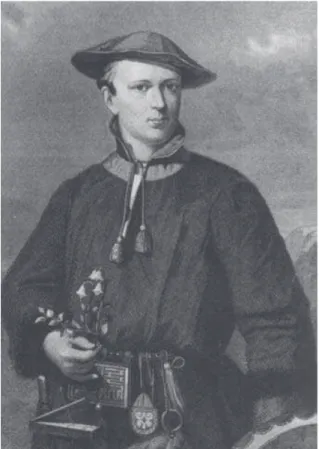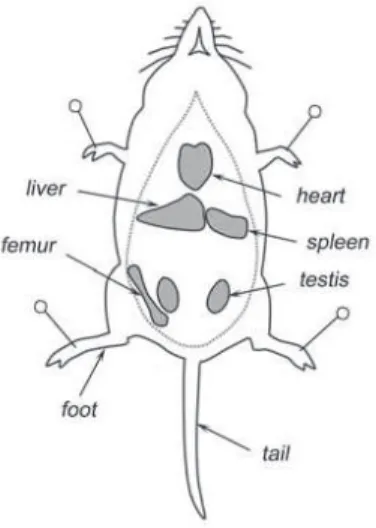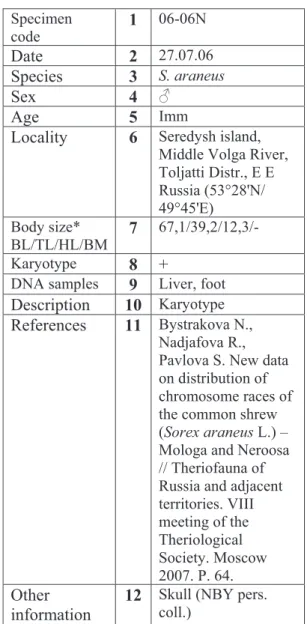Field protocols for the genomic era
N.Sh. Bulatova
1, J.B. Searle
2, R.S. Nadjafova
1, S.V. Pavlova
1, N.V. Bystrakova
31A.N. Severtsov Institute of Ecology and Evolution, Russian Academy of Sciences,
Moscow 119071, Russia. 2Department of Biology, University of York, PO Box 373,
York YO10 5YW, UK. 3Penza State Pedagogical University, Penza 440602, Russia.
E-mails: 1admin@sevin.ru, 2jbs3@york.ac.uk, 3natvibys@mail.ru
Abstract. For many decades karyotype was the only source of overall genomic in-formation obtained from species of mammal. However, approaches have been de-veloped in recent years to obtain molecular and ultimately genomic information directly from the extracted DNA of an organism. Molecular data have accumu-lated hugely for mammalian taxa. The growing volume of studies should motivate fi eld researchers to collect suitable samples for molecular analysis from various species across all their ranges. This is the reason why we here include a molecu-lar sampling procedure within a fi eld work protocol, which also includes more tra-ditional (including cytogenetic) techniques. In this way we hope to foster the de-velopment of molecular and genomic studies in non-standard wild mammals.
Key words: mammalian genome, molecular phylogeography, fi eld studies, molecu-lar sampling procedure, karyotype, Sorex araneus.
I
NTRODUCTIONFor many decades karyotype was the only source of overall genomic information that could be obtained from species of mammal. Up to now, karyotyping has been based on the original technique known as “A colchicine, hypotonic citrate, squash sequence for mam-malian chromosomes” - a title of the most frequently cited paper of C.E. Ford and J.L. Hamerton (1956). Recent researchers con-tinue to practice the same technique with just two differences - sodium citrate is replaced by potassium chloride as a hypotonic solution, and air-drying is used instead of squashing. In general, this procedure is used widely and has been adapted both for fi eld and laboratory studies.
More recently, there has been a develop-ment of molecular methods which will ulti-mately lead to whole-genome information. In
considering wild mammals, much of this work has involved specifi c DNA sequences obtained from extracted DNA of an organism, and fol-lowing the phylogeographic approach to un-derstand the distribution of such sequences and phylogenetic lineages in a geographic context (Avise, 2000; Beheregaray, 2008). The growing volume of phylogeographic studies and more recent approaches involving a much larger proportion of the genome, means that fi eld researchers should collect material in a way that is useful for such molecular work. In this paper we provide these molecular pro-tocols together with other (including cytoge-netic) methods that a fi eld mammalogist may follow in their standard studies of multiple species within their geographic area.
of the common shrew (Sorex araneus Linnae-us, 1758). This small insectivorous mammal has been the subject of particularly detailed study since 1987 when the International Sorex araneus Cytogenetics Committee – ISACC – was formed (Fig. 1, Searle et al., 2007). The standardisation of procedures and data-sets achieved through ISACC has included designation of the standard Sorex araneus
karyotype (Searle et al., 1991), rules to defi ne chromosome races (Hausser et al., 1994) and the generation of comprehensive lists of chro-mosome races (Zima et al., 1996; Wójcik et al., 2003). New needs require some additional protocols and standardisation. This is the rea-son why we considered it appropriate to in-clude a molecular sampling procedure into a set of standardised fi eld protocols, which we trust will be of value as a reference for future studies and a springboard for future extensive genomic research on wild mammals.
G
ENARALR
EMARKSThe common shrew, or, in Latin, Sorex araneus Linnaeus, 1758 – a small terrestrial insectivore – got its scientifi c name from the famous Sweden naturalist Carl von Linné who lived and worked in the 18th century in the vicinity of the ancient university town of Up-psala. Though his own fi eld researches were addressed primarily to wild and cultivated
plants (see Fig. 2), many species of mammal from around the world were included as Lnean species in the great nature catalogues in-defatigably compiled by him.
In the next century in England, Charles Darwin generated the extraordinary “Origin of Species” whose 150 years anniversary we are celebrating in 2009 together with the bi-centenary of Darwin’s birth. It took nearly a full century after the “Origin” before the struc-ture of DNA was discovered (1953) and when modern mammalian cytogenetics originated (1956 – see above). It took another half-cen-tury before genome analysis has become pos-sible for wild mammals, although molecular approaches such as “phylogeography” pre-date that (Avise, 2000).
Fig. 2. Portrait of Carl von Linné painted in 1732 (in Lapland dress and with the fl ower named after him,
Linnea borealis). Fig. 1. ISACC emblem with the image of a common
In its original defi nition, “phylogeog-raphy is a fi eld of study connected with the principles and processes governing the geo-graphic distributions of genealogical lineages, especially those within and among closely related species. As the word implies, phylo-geography deals with historical, phylogenetic components of the spatial distribution of gene lineages” (Avise, 2000, p. 3). The empirical basis for this fi eld grew from mitochondrial (mt) DNA research on fi eld material. So, it is important to obtain samples containing well conserved DNA. Fortunately, the protocol for sample collection is very simple, although it does need care. It relates both to samples for mtDNA and nuclear DNA analysis. Because of the diffi culty in obtaining high quality DNA from museum specimens, fresh samples are enormously important.
F
IELDP
ROCEDURESSpecies to collect
Each project is primarily focussed on a cer-tain species such as the common shrew in our case. However, during fi eldwork, inevitably other small mammal species may be collected which also can be kept and documented. We will not comment here on details relating to animal capture. It is an aspect of fi eldwork separate from our molecular and cytogenetic focus!
Samples for DNA may be obtained from a killed animal at once, or following approxi-mately half an hour, just after the initial part of the chromosome procedure, if the animal is being karyotyped. Different body parts such as feet, tail or ear, as well as internal organs like liver, spleen or heart may be sampled (Fig. 3). It is important to keep the samples of different organs taken from the same animal in differ-ent tubes though they can be removed with the same instruments. The liver (excluding bile) is such a large organ that it can be stored in
sev-eral tubes (useful for specimen exchange). If there are no special sampling needs re-lating to a particular species, 1 to 3 individuals should be collected per trapping locality. Oth-er individuals can be released. The specimens should be given an appropriate code used on the specimen label and in fi eld and laboratory notebooks (Table 1). Details should be record-ed of the species identifi cation, sex, collection site and collector’s name. The geographical coordinates of collection sites should be taken using GPS, if possible.
External measurements of animal
Record the following after killing the ani-mal (Table 1):
1) male/female 2) adult/immature
3) for females, record whether mated (sometimes evident because of a nape scar or white patch), lactating or pregnant
4) weight to nearest 0.1 g
5) head + body length to nearest 0.1 mm 6) tail length to nearest 0.1 mm
7) length of right hind foot to nearest 0.1 mm.
Whole-body specimens
It is valuable that individuals collected are preserved permanently for museum or labo-ratory collections. There are different ways to conserve wet or dry specimens depending
on specialized personal requirements. Once the specimen is adequately sampled for DNA (see below), it is extremely convenient to pre-serve specimens in formalin, because this is an excellent preservative and non-infl amma-ble. However, it must be emphasized that this procedure is only appropriate for those body parts that are not needed for molecular analy-sis. Thus, the specimens may be prepared by removing the guts and internal organs, putting a tag on the hind leg and storing in a container of formalin in the ratio 1 shrew: 10 formalin. These formalin-preserved specimens are eas-ily transported by removing excess formalin and placing those individuals to be sent in a well-sealed plastic bag.
Samples for DNA analysis
For each individual we collect at least two samples for DNA preparations.
1) Part of one of the feet including the toes. The foot should be cut with clean in-struments (ideally use a disposable razor blade – which removes any danger of cross-con-tamination), and stored in a 1.5 ml screw-top plastic tube. Fill the tube with 95-100% etha-nol (pure ethaetha-nol rather than methylated spir-its); there should be at least 10 times as much ethanol as tissue. Make sure that the tube is adequately labelled (e.g. with pencil; the label should not wash off with ethanol). Store at 4°C if possible (otherwise room temperature).
2) The tail tip or ear may be collected in the same way.
3) Soft tissue from the heart, spleen or part of the liver. The animal should be dissect-ed with clean instruments. The heart should be chopped into small pieces with clean in-struments (ideally use a disposable razor blade – which removes any danger of cross-contam-ination). The preservation of tissue follows (1) thereafter.
Please note that it really is critical to have clean instruments when preparing samples
Table 1. An example of the data collected on a small mammal used for cytogenetic and molecular studies (viz. the shrew specimen whose karyotype is presented in Fig. 4). * BL – head and body length, mm / TL – tail length, mm / HL – hindfoot length, mm / BM - body mass, g.
Specimen code
1 06-06N
Date 2 27.07.06
Species 3 S. araneus
Sex 4
Age 5 Imm
Locality 6 Seredysh island,
Middle Volga River, Toljatti Distr., E E Russia (53°28'N/ 49°45'E)
Body size* BL/TL/HL/BM
7
67,1/39,2/12,3/-Karyotype 8 +
DNA samples 9 Liver, foot
Description 10 Karyotype
References 11 Bystrakova N.,
Nadjafova R., Pavlova S. New data on distribution of chromosome races of the common shrew (Sorex araneus L.) – Mologa and Neroosa // Theriofauna of Russia and adjacent territories. VIII meeting of the Theriological Society. Moscow 2007. P. 64.
Other information
for DNA preparations. It is important not to have cross-contamination from one speci-men to another. This is why disposable razor blades are so good. If you are careful there is no need to touch the tissue with any other instruments. Scissors and forceps will carry DNA from previous specimens if they have only been washed with water or ethanol. It is possible to clean DNA from instruments but it is a laborious process: Wipe the instruments, soak them in a 10% bleach solution, rinse very thoroughly with water (if bleach is present on the instruments when you next use them – that will destroy the DNA of the next specimen!), squirt ethanol on all sides of the instruments and fl ame them.
Chromosome preparations
Working with cell suspensions has formed the primary strategy for chromosome prepara-tions since its fi rst description by C.E. Ford
and J.L. Hamerton in 1956. The original basic procedure involves an in vivo colchicine pre-treatment of the specimen, which may also be applied to cultivated cells or post mortem ex-tracted bone marrow cells in vitro. It includes the following stages:
1) Inject 0.5 ml of 0.025 % (w/v) colchi-cine solution intraperitoneally. Leave the ani-mal for 1 h.
2) Kill the animal by cervical dislocation. Remove femurs. Cut off epiphyses. Wash out the marrow into a small vial with warm 1.12% (w/v) sodium citrate solution, using a hypo-dermic syringe with a fi ne needle. [Nowadays: 0.56% potassium chloride is preferred as a hy-potonic solution].
3) Gently aspirate marrow in and out of the syringe until it is broken up into a fi ne sus-pension. Place the vial containing the suspen-sion into a water bath at 37°C. Leave for 10 min.
4) Filter by centrifuging through Ny-lon bolting cloth in a bacterial fi ltration tube. [Nowadays: precipitate cells by centrifuging 5 min at 1000 rpm in a benchtop centrifuge].
5) Fix in chilled acetic-alcohol (1:3), 2 h. Figure 4 shows an example of the fi nal product of chromosome preparation after air-drying. It is a karyotype of the common shrew, illustrating both polymorphism and polytypy, and the chromosomes have been stained and arranged in a standard format for the species (Searle et al., 1991).
Meiosis
The analysis of meiosis is an advanced form of chromosomal study that is valuable, for instance, in hybrid zones between chromo-some races, where heterozygous individuals (see Fig. 4) are found. It is situations where there are confi gurations more complicated than bivalents that meiosis becomes interest-ing. Figure 4 illustrates another interesting
uation to examine meiosis: multiple sex chro-mosomes. Most straightforward is to make meiotic preparations in males, making use of the paired testes (Fig. 4). To make the meiotic chromosome preparations for late prophase I (diakinesis) – metaphase II, the testis tubules should be removed from the tunica and kept in a small Petri dish in hypotonic 1% citrate at room temperature. Then the tubules should be transferred into a vial with acetic-ethanol (1:3) fi xative using forceps and kept there for 10 min. The fi xative solution should be replaced three times. Place the vial into the refrigerator for a period up to 2 weeks. To make slides, take a very small mass of tubules, homogenize them with scissors as fi nely as possible and place a few drops onto a slide (Grafodatsky, Radjabli, 1988). To obtain preparations for the analysis of earlier meiotic stages (in particu-lar, to examine chromosome pairing by visual-ising synaptonemal complexes at pachytene), intact testes should be placed in 10 volumes of cold isotonic solution and forwarded to a laboratory specialised for such studies.
Cell Culture
Potentially it is also possible to collect tis-sue samples for in vitro fi broblast culture in the fi eld. In this case it is very important to follow certain rules strictly, fi rst of all with respect the maintenance of sterility and the transport of samples without exposing them to extremes of temperature when sending them to a labo-ratory that will set up the culture. The tissues samples should only be taken from freshly killed individuals.
A
CKNOWLEDGMENTSThis work is grown as a by-product of studies supported partly by the Russian Foun-dation for Basic Research (RFBR grants 07-04-00102, 08-04-00553) and by the Federal Program “Scientifi c and Research-Pedagogi-cal Staff of Innovated Russia” (2009-1.1-141-063-021).
R
EFERENCESAvise J.C. 2000. Phylogeography. The history and for-mation of species. Cambridge, Massachusetts. 447 p. Beheregaray L.B. 2008. Twenty years of phylogeogra-phy: the state of the fi eld and the challenges for the Southern Hemisphere // Mol. Ecol. 17: 3754-3774. Ford C.E., Hamerton J.L. 1956. A colchicine,
hypo-tonic citrate, squash sequence for mammalian chro-mosomes // Stain Technol. 31(6): 247-251.
Grafodatsky A.S., Radjabli S.I. 1988. Chromosomes of domestic and laboratory mammals. The Atlas. Novosibirsk. 128 p. (In Russian).
Hausser J., Fedyk S., Fredga K., Searle J.B., Volo-bouev V.T., Wójcik J.M., Zima J. 1994. Defi nition and nomenclature of chromosome races of Sorex araneus // Folia Zool. 43 (Suppl.1): 1-9.
Searle J.B., Fedyk S., Fredga K., Hausser J., Volo-bouev V.T. 1991. Nomenclature for the chromo-somes of the common shrew (Sorex araneus) //
Mém. Soc. Vaud. Sc. Natur. 19: 13-22.
Searle J.B., Hausser J., Zima J., Fredga K., Wójcik J.M., Volobouev V.T., Bulatova N.S., Nadjafova R. 2007. The ISACC heritage // Rus. J. Theriol. 6 (2): 123-167.
Wójcik J.M., Borodin P.M., Fedyk S., Fredga K., Hausser J., Mishta A., Orlov V.N., Searle J.B., Volobouev V.T., Zima J. 2003. The list of the chro-mosome races of the common shrew Sorex araneus
(updated 2002) // Mammalia. 67: 169-178.
Zima J., Fedyk S., Fredga K., Hausser J., Mishta A., Searle J.B., Volobouev V.T., Wójcik J.M. 1996. The list of the chromosome races of the common shrew (Sorex araneus) // Hereditas. 125: 97-107.
Received June 11, 2009.



